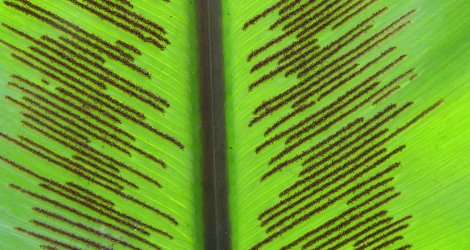Accession Data:
Asplenium nidus L.
- Common Name: Birds Nest Fern, Pakpak-lauin
- Family: Aspleniaceae
- Country of Origin: tropical Asia, Polynesia
- Description: This pantropical, epiphytic fern colonises trees, rock faces and boulders in humid, tropical rainforests. The glossy green, thin, tongue-like fronds have wavy margins and a prominent, almost black midrib. They arise from a densely hairy crown in a radial fashion, somewhat resembling a bird’s nest. It requires warmth and ample humidity.
- Uses: Traditional Medicine Uses
Parts utilized: Leaves
• The plant has been reported to be depurative (purifying) and sedative. • In French Polynesia, used for stings and bites, contraception, chest pains and lice. (Source) • In Hawaii, part of an asthma regimen, mixed and pounded together with flowers of ki, mixed with po. (Details) Shoots used for general debility, sores, ulcers. (source)
Studies • Estrogenic Activity: Maternity and medicinal plants in Vanuatu II. Pharmacological screening of five selected species: Five plant species, including A nidus, were studied for possible estrogenic activity. • Antibacterial Activity: In a study of five medicinal ferns, including Aspenium nidus, all showed antibacterial activity which may justify its use in traditional medicine.
Data from Philippine Alternative Medicine, http://www.stuartxchange.org/Pakpak-Lauin.html
- Culture: Focus on good aeration and drainage. May be grown in sphagnum moss or in a 50% - 60% coarse peat mix with plenty of added perlite and composted bark. Ideal pH at 5.5 - 6.5 but may be slightly lower. From Milestone Agriculture's Birds Nest Fern Culture Sheet
- USDA Zone: 10b-11
Accession Data:
- Accession # 198500858
- Source: Unknown
- Accession Date: 12-31-1985
- Bench: 3108 - EVO: Basal Angiosperms
- Currently: active - healthy
- Qty: 2 confirmed on 03-05-2025
Classification:
- Division: Ferns
- Class: Polypodiopsida
- SubClass: Polypodiidae
- Order: Polypodiales
- SubOrder: Aspleniineae
- Family: Aspleniaceae
- SubFamily:
- Tribe:
- SubTribe:
Flowering Data:
This accession has been observed in bloom on:| Year | Jan | Feb | Mar | Apr | May | Jun | Jul | Aug | Sep | Oct | Nov | Dec | ||||||||||||||||||||||||||||||||||||||||
|---|---|---|---|---|---|---|---|---|---|---|---|---|---|---|---|---|---|---|---|---|---|---|---|---|---|---|---|---|---|---|---|---|---|---|---|---|---|---|---|---|---|---|---|---|---|---|---|---|---|---|---|---|
| 2025 | ||||||||||||||||||||||||||||||||||||||||||||||||||||
| 2024 | ||||||||||||||||||||||||||||||||||||||||||||||||||||
| 2023 | ||||||||||||||||||||||||||||||||||||||||||||||||||||
| 2022 | ||||||||||||||||||||||||||||||||||||||||||||||||||||
| 2021 | ||||||||||||||||||||||||||||||||||||||||||||||||||||
| 2020 | ||||||||||||||||||||||||||||||||||||||||||||||||||||
| 2019 | ||||||||||||||||||||||||||||||||||||||||||||||||||||
| 2018 | ||||||||||||||||||||||||||||||||||||||||||||||||||||
| 2017 | ||||||||||||||||||||||||||||||||||||||||||||||||||||
| 2016 | ||||||||||||||||||||||||||||||||||||||||||||||||||||
| 2015 | ||||||||||||||||||||||||||||||||||||||||||||||||||||
| 2014 | ||||||||||||||||||||||||||||||||||||||||||||||||||||
| 2013 | ||||||||||||||||||||||||||||||||||||||||||||||||||||
References (internal):
References (external):
- Botanica, Turner & Wasson, 1997, CD-ROM Version
- The Plant List (2013). Version 1.1. Accessed 18 May 2015.
data regenerated on Wed, 05 Mar 2025 15:30:01 -0500 [bcm v4.0]
Images:

Additional images for this accession:
Click on thumbnails to enlargeCurrent Accessions in the Aspleniaceae
W/C = Wild Collected = indicates flowering in past 14 days
= indicates flowering in past 14 days
 = images available for this accession
= images available for this accession
 = map available for this accession
= map available for this accession
 = accession added within past 90 days
= accession added within past 90 days

